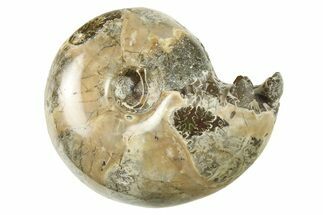This Specimen has been sold.
10.6" Ammonite In Septarian Nodule - Madagascar
This is a 10.6" ammonite fossil preserved in a Septarian nodule from Betsiboka Region, Madagascar. Most of the outer shell of the ammonite has been worn away revealing the inner suture pattern in some areas. The ammonite is unpolished while the Septarian is polished. There are dark calcite crystals growing between the ammonite and the rock.
About Ammonites
Ammonites were ancient marine cephalopods, similar to today's squids and octopuses, but with a defining feature: their distinctive, tightly coiled spiral shells. These shells, resembling those of modern nautiluses, served as both a protective home and a buoyancy aid, allowing ammonites to navigate the prehistoric seas with ease. First emerging around 240 million years ago in the Triassic Period, ammonites thrived for over 175 million years, adapting through numerous forms and sizes. As predatory creatures, they likely fed on smaller marine organisms, using their tentacles to capture prey. However, their long reign came to an end 65 million years ago at the close of the Cretaceous, coinciding with the mass extinction event that also eliminated the dinosaurs.
Ammonites were ancient marine cephalopods, similar to today's squids and octopuses, but with a defining feature: their distinctive, tightly coiled spiral shells. These shells, resembling those of modern nautiluses, served as both a protective home and a buoyancy aid, allowing ammonites to navigate the prehistoric seas with ease. First emerging around 240 million years ago in the Triassic Period, ammonites thrived for over 175 million years, adapting through numerous forms and sizes. As predatory creatures, they likely fed on smaller marine organisms, using their tentacles to capture prey. However, their long reign came to an end 65 million years ago at the close of the Cretaceous, coinciding with the mass extinction event that also eliminated the dinosaurs.
About Septarian
Septarian or septarian nodules are concretions containing angular cavities or cracks, called "septaria", filled with calcite and aragonite. A concretion is a hard, compact mass of rock that often forms around decaying organic matter. In the case of septarian nodules, the concretions formed around decaying sea life in a marine environment.
The exact mechanism for how the cracks form in the concretions is a mystery. One possible mechanism is the dehydration of the clay-rich core of a concretion, causing it to shrink and crack. The cracks could also be caused by gas expansion produced by the decaying organic matter within a concretion. Earthquakes have also been suggested as yet another mechanism.
The cracks in the concretions are then filled in with minerals such as calcite (yellow), aragonite (brown), and sometimes pyrite, causing very interesting patterns. They have often been described as looking like dragon's skin. They are frequently found as geodes with hollow, calcite crystal-filled cavities. More rarely, the fossils that originally started the formation of the concretion are still preserved in the septarian.
Septarian or septarian nodules are concretions containing angular cavities or cracks, called "septaria", filled with calcite and aragonite. A concretion is a hard, compact mass of rock that often forms around decaying organic matter. In the case of septarian nodules, the concretions formed around decaying sea life in a marine environment.
The exact mechanism for how the cracks form in the concretions is a mystery. One possible mechanism is the dehydration of the clay-rich core of a concretion, causing it to shrink and crack. The cracks could also be caused by gas expansion produced by the decaying organic matter within a concretion. Earthquakes have also been suggested as yet another mechanism.
The cracks in the concretions are then filled in with minerals such as calcite (yellow), aragonite (brown), and sometimes pyrite, causing very interesting patterns. They have often been described as looking like dragon's skin. They are frequently found as geodes with hollow, calcite crystal-filled cavities. More rarely, the fossils that originally started the formation of the concretion are still preserved in the septarian.
SPECIES
Unidentified
AGE
LOCATION
Ambondromamy, Betsiboka Region, Madagascar
SIZE
10.6" ammonite, 10.3" tall on Septarian
CATEGORY
SUB CATEGORY
ITEM
#124162
We guarantee the authenticity of all of our specimens.
 Reviews
Reviews














